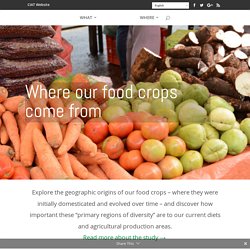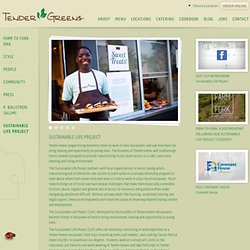

Overfishing: The worst and best fish you can eat. Killing an animal: What it actually means to eat meat. What's the most climate-friendly milk. Areas HARVESTED Comparison □ (Real Scale) Origin of crops. By Colin K.

Khoury, Harold A. Achicanoy, Carlos Navarro-Racines, Steven Sotelo, and Andy Jarvis at the International Center for Tropical Agriculture (CIAT). Version 1.0 (May 2016). This work is licensed under a Creative Commons Attribution 4.0 International (CC BY 4.0). This work is associated with the publication: Khoury CK, Achicanoy HA, Bjorkman AD, Navarro-Racines C, Guarino L, Flores-Palacios X, Engels JMM, Wiersema JH, Dempewolf H, Sotelo S, Ramírez-Villegas J, Castañeda-Álvarez NP, Fowler C, Jarvis A, Rieseberg LH, and Struik PC (2016). About the circular plots Each region has a color representing its own “native” crops and those colors are connected to other regions due the importance of those crops in the diets/agricultural production in other regions. Methods and code for the plots were derived from The Global Flow of People by Nikola Sander, Guy J. About the data. Adventures in Sustainable Eating.
How Does It Grow: Video Teaches Eaters Where Their Food Comes From. When we took a video camera into the heart of Philadelphia to ask passersby how foods like coffee, rice and cinnamon grow, the answers — or rather, the inability to answer — was staggering.

Almost across the board, if the interviewee was over the age of 60, they did well on our pop quiz. If they were younger, no matter their gender or race, they struggled. "What is flour made from? " a man said, pondering the question. "I have no idea. " "Rice? While this test was far from scientific, it presents stirring evidence of the disconnect we have when it comes to our food sources. A recent Australian survey reported that 20 percent of its nation's children believe that pasta comes from animals and 27 percent think that yogurt comes from plants. But does it matter? Let's start with the obvious connection: health. Children are not reputed to be great adventurers of taste: if they can't identify a food on their plate, they're going to need some coaxing. Humans NEED and EAT Biological Diversity! Fermentation makes foods more nutritious, as well as delicious!
Sustainable Life Project. Tender Greens began hiring homeless teens to work in their restaurants and saw how food can bring healing and opportunity to young lives.

The founders of Tender Greens and Scarborough Farms created a program to provide transitioning foster youth access to a safe, consistent learning and living environment. The Sustainable Life Project partners with local organizations to recruit young adults transitioning out of the foster care system to participate in a culinary internship program to learn about where food comes from and what it's like to work in a fast-faced restaurant. Youth transitioning out of foster care face unique challenges that make them especially vulnerable. Distrust, abuse, neglect and general lack of access to resources and guidance often make navigating adulthood difficult.
Without primary needs like housing, vocational training and legal support, these youth frequently don’t have the luxury of dreaming beyond finding a home and employment. Fergus The Forager. Jamie Oliver's Kitchen Garden Project. Home / RHS Campaign for School Gardening. Homepage - School Food Plan. Food for Life Partnership : Home. Resources and Statistics. The Edible Schoolyard Project. Mushroom Cultivation Research and Education. Sustainable Table.
Where botany meets the cutting board.